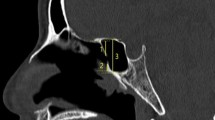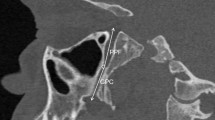Abstract
Purpose
To describe the relation of the sphenoid ridge (SR) with the surrounding anatomical structures in healthy children when approaching the anterior and middle fossae.
Methods
Computed tomography of 180 pediatric patients (90 males / 90 females), aged 1–18 years were included the study. The size of the lesser wing (LW) and the distances of the LW to certain landmarks were measured.
Results
The LW length was 28.48 ± 8.15 mm. The LW widths at the midline and the midpoint and lateral point of the SR were 7.78 ± 1.74 mm, 2.84 ± 0.81 mm, and 1.91 ± 0.64 mm, respectively. The distance between the midpoint of the SR and the crista galli was 28.22 ± 5.56 mm, and the distance between the crista alaris and internal auditory meatus was 51.73 ± 5.79 mm. The linear function was calculated as y = 18.748 + 1.024 × age for SR length, y = 6.046 + 0.182 × age for the midline width of SR, y = 2.367 + 0.050 × age for the midpoint width of SR, y = 1.249 + 0.069 × age for the crista alaris width, y = 21.727 + 0.683 × age for the distance between the SR midpoint and the crista galli, and y = 43.614 + 0.855 × age for the distance between the crista alaris and internal auditory meatus.
Conclusion
All measured parameters increased irregularly with advancing age. Furthermore, our regression equations representing the growth dynamics of SR may be used to estimate these parameters.



Similar content being viewed by others
Data availability
No datasets were generated or analysed during the current study.
References
Tubbs RS, Salter EG, Oakes WJ (2007) Quantitation of and measurements utilizing the sphenoid ridge. Clin Anat 20(2):131–134. https://doi.org/10.1002/ca.20255
Guinto G, Abello J, Félix I, González J, Oviedo A (1997) Lesions confined to the sphenoid ridge: differential diagnosis and surgical treatment. Skull Base Surg 7(3):115–121. https://doi.org/10.1055/s-2008-1058602
MacCarty CS (1972) Meningiomas of the sphenoidal ridge. J Neurosurg 36:114–120. https://doi.org/10.3171/jns.1972.36.1.0114
Nathal E, Gomez-Amador JL (2005) Anatomic and surgical basis of the sphenoid ridge keyhole approach for cerebral aneurysms. Neurosurgery 56(1 Suppl):178–185. https://doi.org/10.1227/01.neu.0000145967.66852.96
Kahilogullari G, Uz A, Eroglu U, Apaydin N, Yesilirmak Z, Baskaya MK, Egemen N (2012) Does the sphenoid angle effect the operation strategy? Anatomical and radiological investigation. Turk Neurosurg 22(5):618–623. https://doi.org/10.5137/1019-5149.JTN.5790-12.0
Lin J, Nauta HJ, Olivero W (2001) Anatomical relationships between Sylvian fissure and the sphenoid ridge. Neurol Res 23(6):645–646. https://doi.org/10.1179/016164101101198947
Spiriev T, Poulsgaard L, Fugleholm K (2016) One piece orbitozygomatic approach based on the sphenoid ridge keyhole: anatomical study. J Neurol Surg B Skull Base 77(3):199–206. https://doi.org/10.1055/s-0035-1564590
Kizilkanat ED, Boyan N, Tekdemir İ, Soames R, Oguz O (2007) Surgical importance of the morphometry of the anterior and middle cranial fossae. Neurosurg Q 17(1):60–63. https://doi.org/10.1097/WNQ.0b013e318033a5b7
Lan Z, Richard SA, Li J, Xu J, You C (2018) A giant solid cavernous hemangioma mimicking sphenoid wing meningioma in an adolescent: a case report. Med (Baltim) 97(44):e13098. https://doi.org/10.1097/MD.0000000000013098
MacCarty CS, Gogela LJ (1949) Meningioma of the sphenoid ridge in a child. J Neurosurg 6(2):182–186. https://doi.org/10.3171/jns.1949.6.2.0182
Wasserzug O, DeRowe A, Ringel B, Fishman G, Fliss DM (2018) Open approaches to the anterior skull base in children: review of the literature. J Neurol Surg B Skull Base 79:42–46. https://doi.org/10.1055/s-0037-1621739
Weninger WJ, Müller GB (1999) The parasellar region of human infants: cavernous sinus topography and surgical approaches. J Neurosurg 90:484–490. https://doi.org/10.3171/jns.1999.90.3.0484
Goodway JD, Ozmun JC, Gallahue DL (2019) Understanding motor development: infants, children, adolescents, adults. Jones & Bartlett Learning, Burlington
Hughes DC, Kaduthodil MJ, Connolly DJ, Griffiths PD (2010) Dimensions and ossification of the normal anterior cranial fossa in children. AJNR Am J Neuroradiol 31:1268–1272. https://doi.org/10.3174/ajnr.A2107
Laine FJ, Nadel L, Braun IF (1990) CT and MR imaging of the central skull base. Part 1: techniques, embryologic development, and anatomy. Radiographics 10:591–602. https://doi.org/10.1148/radiographics.10.4.2198631
Nemzek WR, Brodie HA, Hecht ST, Chong BW, Babcook CJ, Seibert JA (2000) MR, CT, and plain film imaging of the developing skull base in fetal specimens. AJNR Am J Neuroradiol 21:1699–1706 PMID: 11039353
Ricciardelli EJ (1995) Embryology and anatomy of the cranial base. Clin Plast Surg 22:361–372 PMID: 7554712
Lang J (1995) Skull base and related structures: atlas of clinical anatomy, 2nd edn. Schattauer, Stuttgart, Germany
Jacquemin C, Mullaney P, Bosley TM (2001) Abnormal development of the lesser wing of the sphenoid with microphthalmos and microcephaly. Neuroradiology 43(2):178–182. https://doi.org/10.1007/s002340000455
Morard M, Tcherekayev V, de Tribolet N (1994) The superior orbital fissure: a microanatomical study. Neurosurgery 35(6):1087–1093. https://doi.org/10.1227/00006123-199412000-00011
Coscarella E, Baskaya MK, Morcos JJ (2003) An alternative extradural exposure to the anterior clinoid process: the superior orbital fissure as a surgical corridor. Neurosurgery 53(1):162–166. https://doi.org/10.1227/01.neu.0000068866.22176.07
Sato S, Kashimura H, Akamatsu Y, Fujiwara S, Kubo Y, Ogasawara K (2022) Small sphenoid ridge as a factor associated with laterally deviated proximal Sylvian fissure in patients undergoing pterional craniotomy. World Neurosurg 167:e705–e709. https://doi.org/10.1016/j.wneu.2022.08.069
Funding
This research did not receive any specific grant from funding agencies in the public, commercial, or not-for-profit sectors.
Author information
Authors and Affiliations
Contributions
B.C.A., U.E. and O.B. conceived and designed the study. B.C.A., Ö.M.Ö., F.G. and S.D. collected and analyzed the radiological data. B.C.A., M.Q.M.G.A.K., U.E., and O.B. interpreted the results and contributed to the drafting of the manuscript. B.C.A. and O.B. contributed equally to writing the main manuscript text. All authors critically reviewed and approved the final version of the manuscript.
Corresponding author
Ethics declarations
Ethical approval
The Clinical Research Ethics Committee of Ankara University approved this retrospective study (No: 2024/98).
Informed consent
The need for informed consent from the patient was waived by the Institutional Review Board because of the retrospective nature of the study.
Conflict of interest
The authors declare no conflict of interest.
Additional information
Publisher’s Note
Springer Nature remains neutral with regard to jurisdictional claims in published maps and institutional affiliations.
Rights and permissions
Springer Nature or its licensor (e.g. a society or other partner) holds exclusive rights to this article under a publishing agreement with the author(s) or other rightsholder(s); author self-archiving of the accepted manuscript version of this article is solely governed by the terms of such publishing agreement and applicable law.
About this article
Cite this article
Alpergin, B.C., Eroglu, U., Özpişkin, Ö.M. et al. Anatomical features of the sphenoid ridge in the pediatric population. Childs Nerv Syst (2024). https://doi.org/10.1007/s00381-024-06391-y
Received:
Accepted:
Published:
DOI: https://doi.org/10.1007/s00381-024-06391-y




